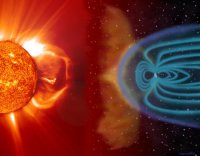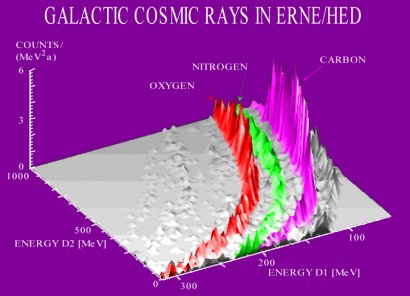Heliosphere
Solar wind and alien atoms
 |
|
The Sun's magnetic field and plasma releases directly affect the Earth and the rest of the Solar System |
Instruments
Two instruments on SOHO are dedicated to general studies of the solar wind, investigating its composition and overall behaviour:
- CELIAS (Charge, Element and Isotope Analysis System) detects the solar wind directly, as it blows past SOHO, and analyses the density and nature of the charged particles present in it. It provides a brief warning of gusts in the solar wind, which arrive at SOHO 30-60 minutes before they reach the Earth.
- SWAN (Solar Wind Anisotropies) is the only instrument in SOHO that turns its back on the Sun in order to examine the whole sky. It detects alien hydrogen atoms by their characteristic ultraviolet glow. The hydrogen comes from interstellar space and pervades the Solar System, but impacts by particles in the solar wind tear electrons from the atoms so that the hydrogen no longer glows. The resulting pattern of brightness in the sky is therefore a guide to the vigour of the solar wind.
Q & A on the solar wind
What chemical elements are represented in the solar wind?
CELIAS has detected many that were previously unrecorded in the solar wind, and the elements and isotopes now range from hydrogen-1 to nickel-62. The proportions of the various constituents and the extent of their ionization (loss of electrons) are different in the slow and fast solar windstreams. This information feeds back into the theories of how the solar wind is created.
Is the solar wind equal in all directions?
No, SWAN sees a groove cut in the interstellar hydrogen by exceptional damage done by the slow solar wind. Coming typically from the Sun's equatorial region, the slow windstream remains more concentrated than the fast wind, which spreads out to fill most of the heliosphere. Moreover, the slow wind is more effective in stripping electrons from the interstellar hydrogen. The groove was very clear when the Sun was quiet (1996-97) but the picture is likely to be more complicated at the maximum of solar activity (2000).
Where do the alien atoms come from?
From the direction of the constellation Ophiuchus, near to Scorpius. SWAN has pinpointed the source direction of the interstellar breeze more accurately than ever before. The SWAN team has also inferred its speed (21 kms-1) after making allowance for the acceleration of the incoming atoms by the Sun's gravity. The Sun's deflection of the passing atoms has a focusing effect, creating a solar halo of interstellar helium observed by another SOHO instrument, UVCS.
What becomes of the alien atoms?
Most of them continue on their way, back to interstellar space, after passing through the Solar System. CELIAS sees some of those that lost their electrons being picked up by the solar wind. They are swept away towards the boundary of the heliosphere, many billions of kilometres away. But some of these pick-up ions are then accelerated back towards the inner Solar System, as 'anomalous cosmic rays' registered by SOHO's particle detectors, COSTEP and ERNE. Other wanderers replace their missing electrons and return as energetic hydrogen atoms, detected by CELIAS.
Energetic particles
The magnetic explosion during a solar flare accelerates electrons and atomic nuclei to significant fractions of the speed of light. Energetic particles from the Sun pose a threat to astronauts and satellites, and even to computers on the ground. Unlike much slower atomic particles in the solar wind, which travel straight out from the Sun, the energetic particles follow curved lines of the Sun's interplanetary magnetic field. The particles slant in towards the Earth from the west at about 45 degrees to the direction of the Sun. When they hit SOHO, they appear as 'snow' in imaging instruments.
Instruments
SOHO has two sets of telescopes for gauging the energetic particles:
- COSTEP (Comprehensive Suprathermal and Energetic Particle Analyzer)
- ERNE (Energetic and Relativistic Nuclei and Electron Experiment)
Both COSTEP and ERNE provide complementary detectors for various types of particles and energy bands, all angled to look along the magnetic field line that guides the particles. ERNE's detectors work at the higher energies.
 |
|
3-D graph of galactic cosmic radiation identified by ERNE's high energy detector |
Q & A on energetic particles
Which eruptions on the Sun produce energetic particles?
Some do, some don't. SOHO's great advantage in seeking an explanation is that bursts of particles can be directly related to events in the solar atmosphere seen by other instruments on the same spacecraft. The scientists hope to find ways of predicting the particle bursts.
What do the particles reveal about their origins?
By analysing the chemical elements present among the energetic particles, and their state of electric charge, scientists can learn about the circumstances of their acceleration. Some of the energetic particles don't even come from the Sun, but are 'anomalous cosmic rays' accelerated far out in space by shock waves in the solar wind.
